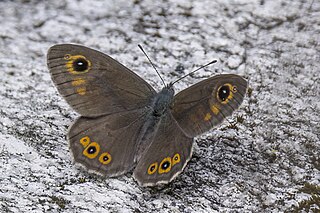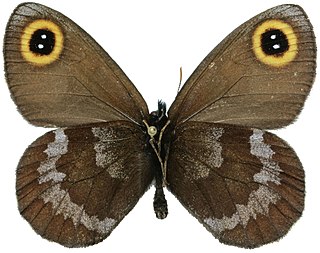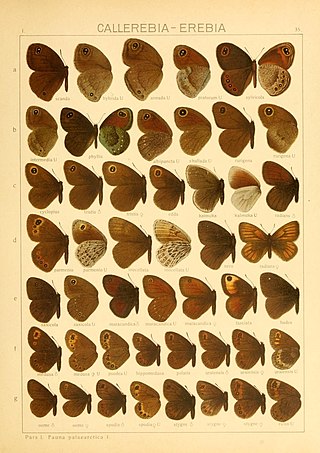
The meadow brown is a butterfly found in the Palearctic realm. Its range includes Europe south of 62°N, Russia eastwards to the Urals, Asia Minor, Iraq, Iran, North Africa and the Canary Islands. The larvae feed on grasses.

The dark green fritillary is a species of butterfly in the family Nymphalidae. The insect has a wide range in the Palearctic realm - Europe, Morocco, Iran, Siberia, Central Asia, China, Korea, and Japan.

Cyaniris semiargus, the Mazarine blue, is a Palearctic butterfly in the family Lycaenidae.
Hipparchia azorina, the Azores grayling, is a species of butterfly in the family Nymphalidae. It is endemic to the Azores. Its natural habitats are temperate forests and temperate grassland. It is threatened by habitat loss.

Coenonympha oedippus, the false ringlet, is a species of butterfly in the subfamily Satyrinae. It is found in Austria, Belgium, the Netherlands, France, Hungary, Italy, Japan, Kazakhstan, Liechtenstein, Mongolia, Poland, Russia, Slovakia, Slovenia, Spain, Switzerland, and Ukraine. It is extirpated from Bulgaria, Germany, and Slovakia.

Parnassius tenedius, the tenedius Apollo, is an east Palearctic member of the snow Apollo genus (Parnassius) of the swallowtail family (Papilionidae). Populations range from Siberia and the Far East of Russia to the western Chukchi Peninsula, Mongolia and north China. The larva feeds on Corydalis species. In the northern part of its range it is a low altitude butterfly; further south it is montane.

Lasiommata maera, the large wall brown, is a butterfly in the family Nymphalidae.

Lopinga achine, the woodland brown, is a Palearctic butterfly in the family Nymphalidae.

Coenonympha hero, the scarce heath, is a butterfly species belonging to the family Nymphalidae.

Coenonympha glycerion, the chestnut heath, is a butterfly species belonging to the family Nymphalidae. It can be found in Eastern Europe and east across the Palearctic to Siberia and the Caucasus to North Korea.

Lasiommata petropolitana, the northern wall brown, is a butterfly species belonging to the family Nymphalidae. It can be found in large parts of Europe, from the Pyrenees and Alps up to Scandinavia and Finland, east to Russia and Siberia.

Mythimna obsoleta, the obscure wainscot, is a moth of the family Noctuidae. The species was first described by Jacob Hübner in 1803. It is found in Europe, from southern Fennoscandia to Spain, Italy and the Balkans, the European part of Russia, the Caucasus, Kazakhstan, Kyrgyzia, southern Siberia, Turkey, the Ural, Mongolia, the Russian Far East, the Korean Peninsula, China and Hokkaido and Honshu in Japan.

Chazara briseis, the hermit, is a butterfly species belonging to the family Nymphalidae. It can be found in North Africa, southern Europe, Asia Minor, the Caucasus, Kazakhstan, Central Asia through Afghanistan, and north-western China and Tuva. It is found on steppe and in other dry grassy places between 500 and 2,500 meters.

Leptidea amurensis is a butterfly of the family Pieridae. It is found from western Siberia to the Ussuri region and in North Korea, China, Mongolia and Japan.

Erebia cyclopius is a species of butterfly of the subfamily Satyrinae in the family Nymphalidae. It is found through Siberia, northern Mongolia, northern China and North Korea. The habitat consists of forest edges, flowery meadows and sparse larch forests.

Boloria selenis is a species of butterfly in the family Nymphalidae. It is found from the Volga basin to Japan.

Chazara persephone, the dark rockbrown, is a butterfly species belonging to the family Nymphalidae. It can be found from Crimea across the Caucasus and north of the Middle East to Iran; from the southern Urals across Kazakhstan to the southern Altai and west Siberia.

Arethusana is a butterfly genus from the subfamily Satyrinae of the brush-footed butterfly family (Nymphalidae). It is composed of only one species, Arethusana arethusa, the false grayling.

Tongeia fischeri, or Fischer's blue, is a butterfly of the family Lycaenidae. It was described by Eduard Friedrich Eversmann in 1843. It is found in south-eastern Europe, the southern Ural, northern and eastern Kazakhstan, south-western and southern Siberia, the Russian Far East, Mongolia, China, Korea and Japan.

Erebia edda is a small butterfly found in the East Palearctic that belongs to the browns family.




















